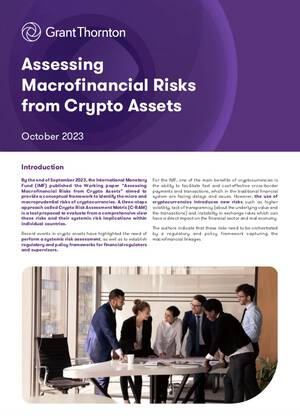-
Risk Advisory
[description]
-
Blockchain & Crypto LAB
After the boom of the last few years, the digital asset ecosystem has managed to position itself as one of the sectors of reference and with an exponential growth forecast. At Grant Thornton, we help our clients to explore all aspects of this technology, to create tailored solutions that bring value to the business and address problems and inefficiencies in the business sector.

Recent events in crypto assets have highlighted the need of perform a systemic risk assessment, as well as to establish regulatory and policy frameworks for financial regulators and supervisors.
For the IMF, one of the main benefits of cryptocurrencies is the ability to facilitate fast and cost-effective cross-border payments and transactions, which in the traditional financial system are facing delays and issues. However, the use of cryptocurrencies introduces new risks such as higher volatility, lack of transparency (about the underlying value and the transactions) and instability in exchange rates which can have a direct impact on the financial sector and real economy.
The authors indicate that these risks need to be orchestrated by a regulatory and policy framework capturing the macrofinancial linkages.
C-RAM approach to evaluate risks of cryptocurrencies
The C-RAM tool is structured to ensure a systematic risk assessment with a three-step approach which allows to identify, measure, understand and monitoring potential risks:
- Decision tree – Quantitative and qualitative assessment to identify key risks in a particular country and to provide key sectors to be evaluated according to the crypto assets economic significance in the country.
- Country risk mapping – Quantify the risks identified and evaluate the vulnerabilities (systemic importance & risks, such as credit, concentration, liquidity, market, regulatory and operational).
- Identify policy options to mitigate risks, such as, insurance mechanisms, data provisioning, national/international regulatory frameworks, additional Risk Weighted Assets buffers for crypto exposure for banks.
It allows to create a map of Global Crypto Risks for or from crypto assets with implications for macroeconomic stability and systemic risk.
The Paper shows how to apply the C-RAM to specific countries such as El Salvador or Vietnam.
Finally, there are key challenges highlighted by IMF:
- better data availability (more granular and with higher frequency) would help to quantify the impact of global crypto risks at the country level.
- promote an effective monitoring and supervision which is prevented by the decentralized market and governance structure of the crypto eco system.
- reinforce micro and macroprudential supervision to avoid vulnerabilities.
From Grant Thornton we believe that the paper provides a mechanism to promote the balance between taking advantage of the benefits of cryptocurrencies, mitigating the risks inherent to the activity to safeguard global financial stability.
See the Working Paper in the following link.
For more information on this topic, consult with our experts.
